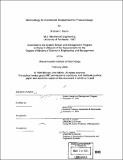| dc.contributor.advisor | Daniel Frey. | en_US |
| dc.contributor.author | Martin, Michael J. (Michael John), 1962- | en_US |
| dc.contributor.other | System Design and Management Program. | en_US |
| dc.date.accessioned | 2006-03-24T18:00:17Z | |
| dc.date.available | 2006-03-24T18:00:17Z | |
| dc.date.copyright | 2000 | en_US |
| dc.date.issued | 2000 | en_US |
| dc.identifier.uri | http://hdl.handle.net/1721.1/29888 | |
| dc.description | Thesis (S.M.)--Massachusetts Institute of Technology, System Design & Management Program, 2000. | en_US |
| dc.description | Includes bibliographical references (p. 101-104). | en_US |
| dc.description.abstract | An integrative methodology for architecture development in a product development environment is described. The methodology combines the use of the design structure matrix technique with constraint-based modeling to create a process that satisfies the following requirements: 1. Provide a means for modeling the system that provides the capability to gain feedback on proposed decisions. This promotes rapidly system learning. 2. Provide a definition of the linkage between product requirements and design parameters. 3. Provide documentation that makes the architecture explicit and enables others to have access to the architectural knowledge. 4. Increase confidence in the proposed system so that product design can proceed with a minimum of risk. The application of the methodology in the context of the development of the xerographic module architecture for color printing system is described. The project was a clean sheet design using a new color architecture and implementing seven new technologies. A significant result is that once the architecture was accepted and placed under change control, the architecture has not changed in four years. Traditionally, similar projects have had to make significant changes as the design matured. Based on the case study, there is anecdotal evidence to support the hypothesis that the methodology can be successfully used to develop complex systems. It is shown that the methodology is closely aligned to the product development process. During the pre-concept and concept phases, the models were used to develop the system architecture. During the detailed design phase, the models can be used to maintain the integrity of the architecture as the design and technologies mature. Finally, in order for the methodology to be successfully applied it must have the full support of program management and the design and technology organizations. | en_US |
| dc.description.statementofresponsibility | by Michael J. Martin. | en_US |
| dc.format.extent | 104 p. | en_US |
| dc.format.extent | 5816523 bytes | |
| dc.format.extent | 5828844 bytes | |
| dc.format.mimetype | application/pdf | |
| dc.format.mimetype | application/pdf | |
| dc.language.iso | eng | en_US |
| dc.publisher | Massachusetts Institute of Technology | en_US |
| dc.rights | M.I.T. theses are protected by copyright. They may be viewed from this source for any purpose, but reproduction or distribution in any format is prohibited without written permission. See provided URL for inquiries about permission. | en_US |
| dc.rights.uri | http://dspace.mit.edu/handle/1721.1/7582 | |
| dc.subject | System Design and Management Program. | en_US |
| dc.title | Methodology for architecture development for product design | en_US |
| dc.type | Thesis | en_US |
| dc.description.degree | S.M. | en_US |
| dc.contributor.department | System Design and Management Program. | en_US |
| dc.identifier.oclc | 47260166 | en_US |
